Africa is home to a diverse array of owl species, with 14 distinct varieties captivating the continent’s skies. These enigmatic birds, characterized by their nocturnal habits and distinctive hooting calls, play crucial roles in maintaining ecological balance.
Ranging from the dense rainforests to the expansive savannas, these owls have adapted to diverse environments, showcasing the adaptability and resilience of these fascinating creatures.
The 14 owl species in Africa exhibit various sizes, plumage colors, and hunting strategies.
From the powerful and elusive Verreaux’s Eagle-Owl, with its striking ear tufts, to the diminutive Pearl-spotted Owlet that skillfully camouflages among the branches, each species contributes to the rich tapestry of Africa’s biodiversity.
14 Owls of Africa
As predators, these owls contribute significantly to controlling rodent populations, acting as silent custodians of the ecosystems they inhabit.
Let’s explore the intriguing world of Africa’s 14 owl species unveiling a captivating journey into the realm of these mysterious and essential avian inhabitants.
1. African Grass Owl
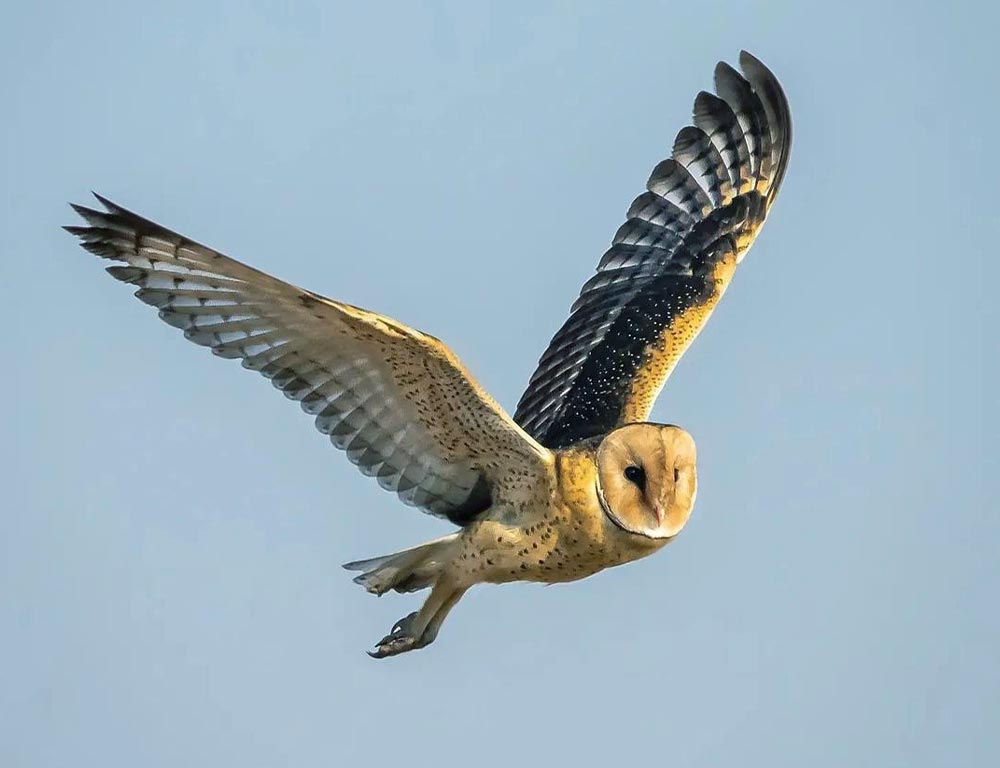
- Scientific name: Tyto capensis
- Size: 35-40 cm
- Weight: 260-370 g
- Population: Data varies; some populations are declining.
- Life span: Up to 12 years
- Food: Mainly small rodents and insects
- Wingspan: Approximately 90 cm
- Status: Near Threatened
The African Grass Owl, Tyto capensis, is a captivating nocturnal bird inhabiting grasslands and savannas. With a modest size of 35-40 cm and a distinctive heart-shaped facial disc, it thrives on a diet primarily consisting of small rodents and insects.
Recognized by its cryptic plumage that aids in blending with the grassy landscapes, these owls are elusive and expertly adapted to their environment.
Facing threats from habitat loss and changes in land use, the African Grass Owl’s population is of concern, earning it a Near Threatened status.
The ability to maintain a delicate balance in grassland ecosystems makes the conservation of this species crucial for preserving Africa’s biodiversity.
2. Barn Owl

- Scientific name: Tyto alba
- Size: 33-39 cm
- Weight: 200-550 g
- Population: Widespread and not globally threatened
- Life span: 1-2 years in the wild
- Food: Mainly small mammals, particularly rodents
- Wingspan: Around 80-95 cm
- Status: Least Concern
The Barn Owl, Tyto alba, is a globally distributed species known for its distinctive heart-shaped facial disc and white, ghostly appearance.
Preferring a variety of habitats, including farmlands and open woodlands, these owls play a valuable role in controlling rodent populations.
Their exceptional hearing and silent flight enable them to hunt with precision in low-light conditions. Despite facing threats from habitat loss and pesticide use, the Barn Owl maintains a stable population and is classified as Least Concern.
The cooperation of farmers and conservation efforts contribute to the successful coexistence of these nocturnal hunters with human activities.
3. African Scops Owl
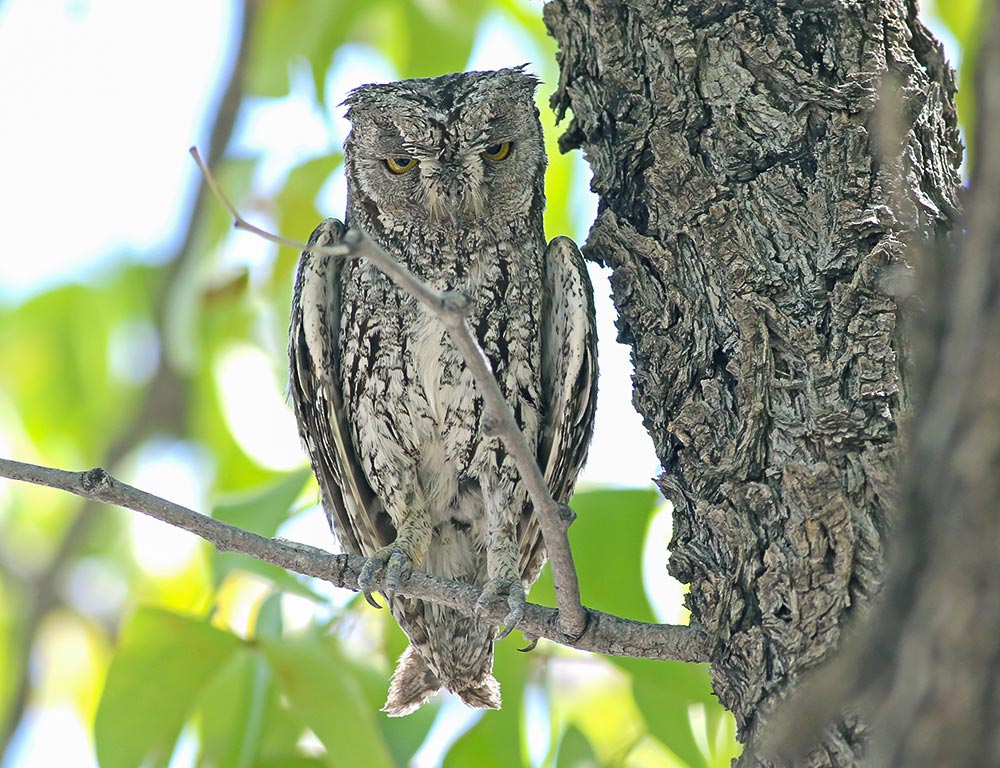
- Scientific name: Otus senegalensis
- Size: 19-22 cm
- Weight: 75-145 g
- Population: Stable; no major conservation concerns
- Life span: Up to 10 years
- Food: Insects, small birds, and rodents
- Wingspan: Approximately 50-54 cm
- Status: Least Concern
The African Scops Owl, Otus senegalensis, embodies the charm of smaller owl species with its compact size and distinctive ear tufts.
Inhabiting various landscapes from savannas to woodlands, these owls exhibit a diverse diet, preying on insects, small birds, and rodents.
With a stable population and no significant conservation concerns, the African Scops Owl is classified as Least Concern.
Their nocturnal lifestyle and ability to adapt to different environments make them resilient, contributing to the avian tapestry of Africa.
4. Southern White-faced Owl
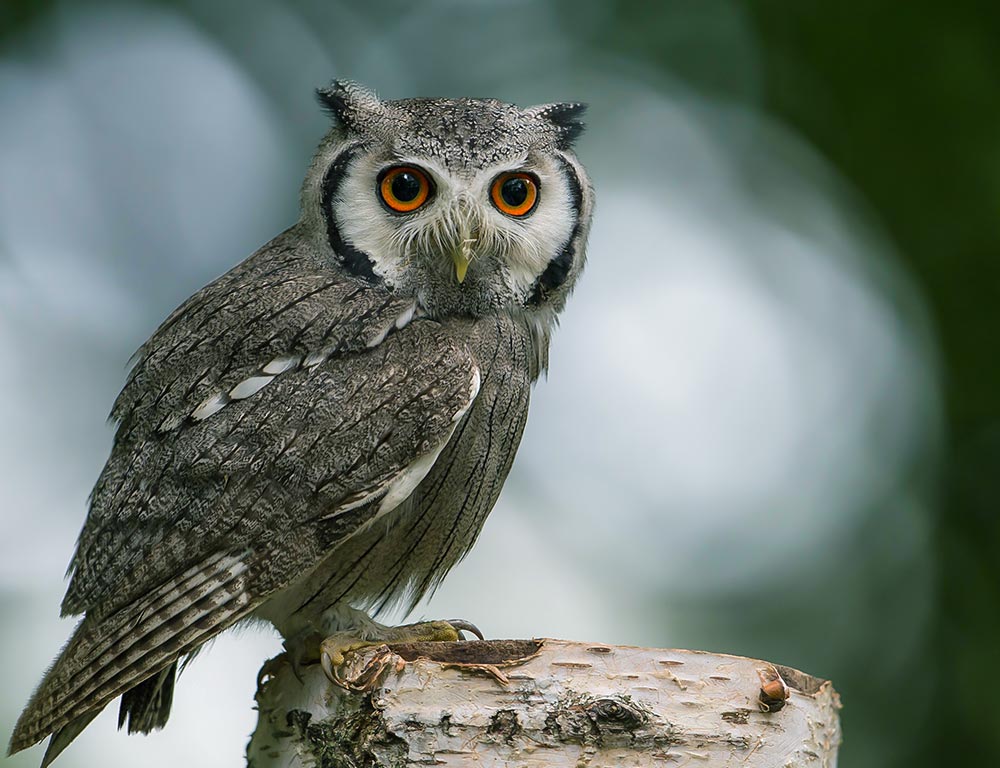
- Scientific name: Ptilopsis granti
- Size: 20-30 cm
- Weight: 160-300 g
- Population: Stable; widespread across Africa
- Life span: Up to 15 years
- Food: Insects, small mammals, and birds
- Wingspan: Approximately 50-61 cm
- Status: Least Concern
The Southern White-faced Owl, Ptilopsis granti, is recognized for its striking facial features, adorned with white markings that resemble a mask.
Occupying a variety of habitats, including forests and savannas, these medium-sized owls exhibit a diverse diet, feeding on insects, small mammals, and birds.
With a stable population and a wide distribution across Africa, the Southern White-faced Owl faces no imminent threats and is classified as Least Concern.
Their adaptability to different environments and versatile hunting techniques make them a fascinating and resilient species within the African owl community.
5. African Wood Owl
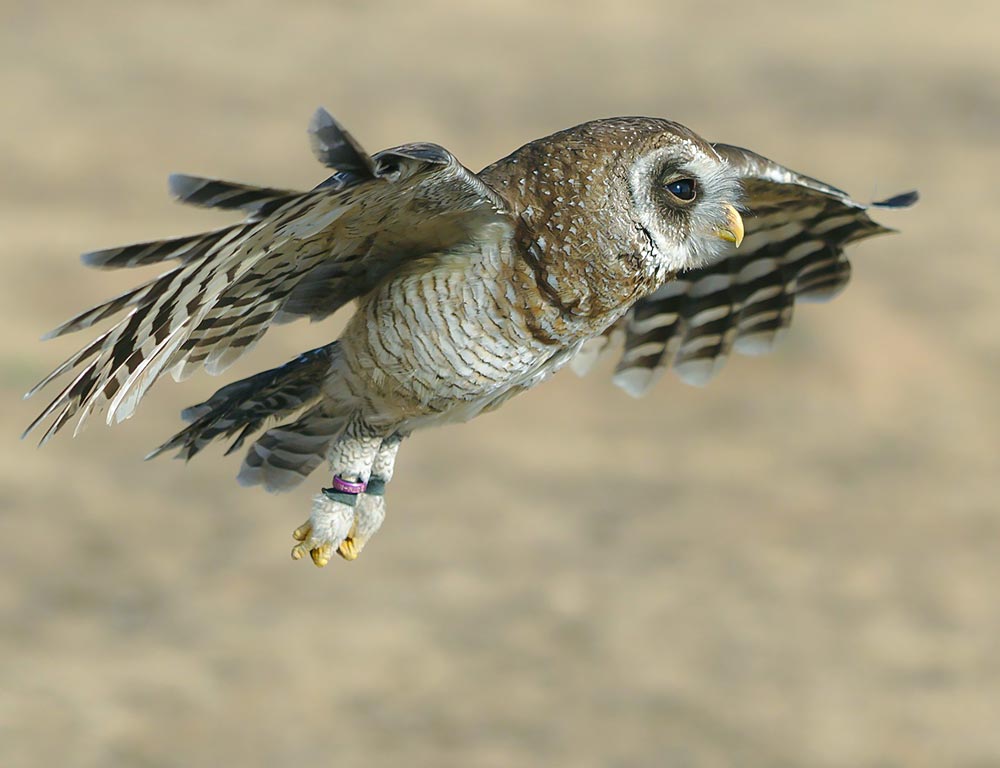
- Scientific name: Strix woodfordii
- Size: 35-40 cm
- Weight: 400-600 g
- Population: Generally stable
- Life span: 10-15 years
- Food: Small mammals, birds, and insects
- Wingspan: Approximately 85 cm
- Status: Least Concern
The African Wood Owl, Strix woodfordii, is a medium-sized owl species characterized by its round facial disc and dark eyes.
Inhabiting a range of wooded environments, from forests to open woodlands, these owls are adept hunters, preying on small mammals, birds, and insects.
With a generally stable population and a wide distribution, the African Wood Owl faces no immediate conservation threats and is classified as Least Concern.
Their adaptable nature and diverse diet contribute to their success in various habitats, making them a captivating presence in Africa’s avian landscape.
6. Spotted Eagle Owl
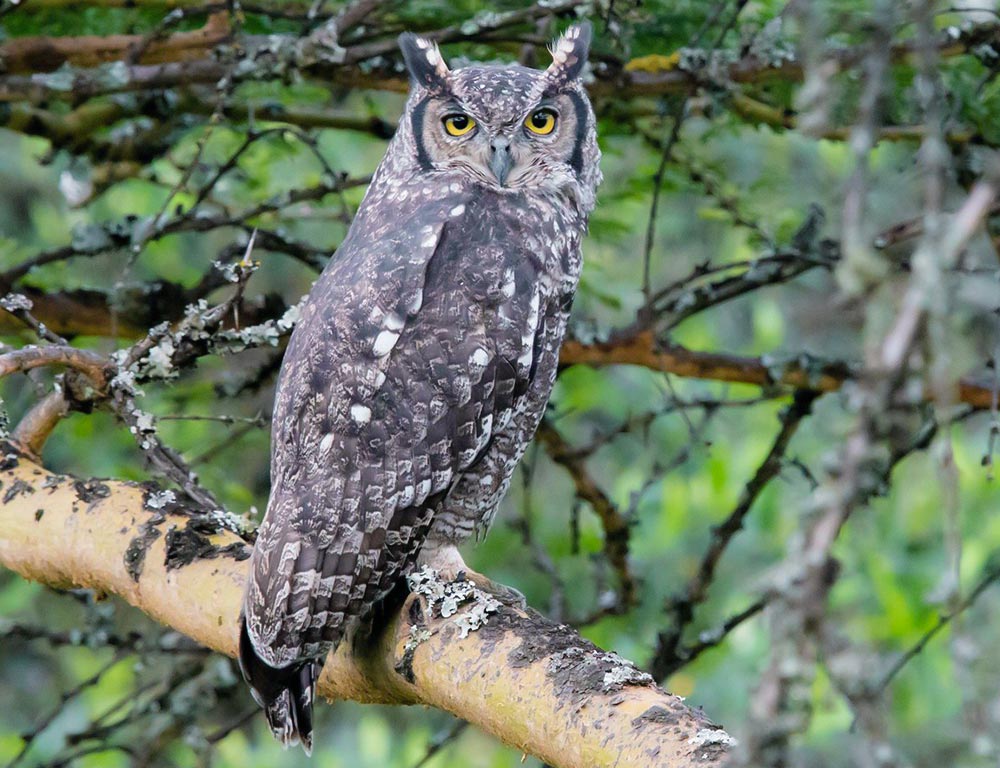
- Scientific name: Bubo africanus
- Size: 45-55 cm
- Weight: 650-1000 g
- Population: Common and widespread
- Life span: 5-10 years
- Food: Mainly rodents, birds, and insects
- Wingspan: Around 125 cm
- Status: Least Concern
The Spotted Eagle Owl, Bubo africanus, is a charismatic owl species recognizable by its prominent ear tufts and distinctive facial markings.
Thriving in diverse habitats, from savannas to urban areas, these owls exhibit a varied diet, including rodents, birds, and insects. Common and widespread, the Spotted Eagle Owl faces no significant threats, earning it a Least Concern status.
Their adaptability to human-altered landscapes and efficient rodent control make them a familiar and appreciated presence in both natural and urban environments across Africa.
7. Verreaux’s Eagle Owl
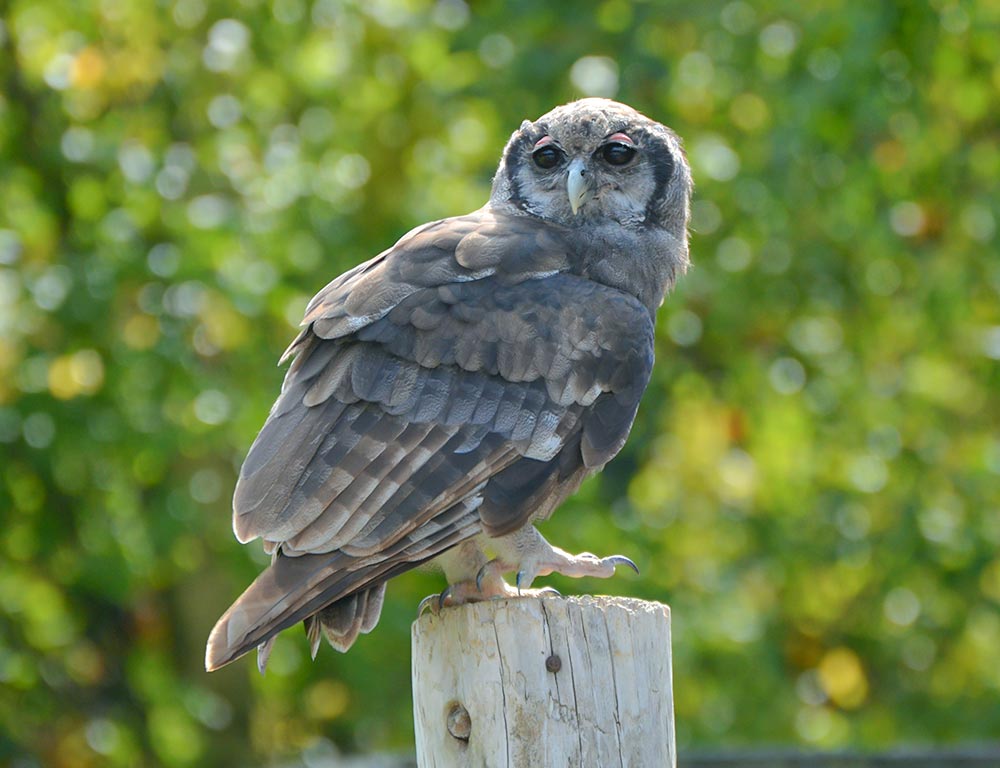
- Scientific name: Bubo lacteus
- Size: 58-71 cm
- Weight: 1900-2600 g
- Population: Stable; some local declines
- Life span: Up to 20 years
- Food: Large birds and mammals
- Wingspan: Approximately 140 cm
- Status: Least Concern
Verreaux’s Eagle Owl, Bubo lacteus, is a majestic large-sized owl known for its impressive stature and striking ear tufts.
Inhabiting diverse landscapes, including savannas and rocky areas, these owls are powerful predators, preying on large birds and mammals. While their overall population is stable, some local declines due to habitat loss pose localized concerns.
Classified as Least Concern, the conservation of their habitats is crucial to ensuring the continued success of Verreaux’s Eagle Owl as a prominent and awe-inspiring species within Africa’s avian community.
8. Cape Eagle Owl
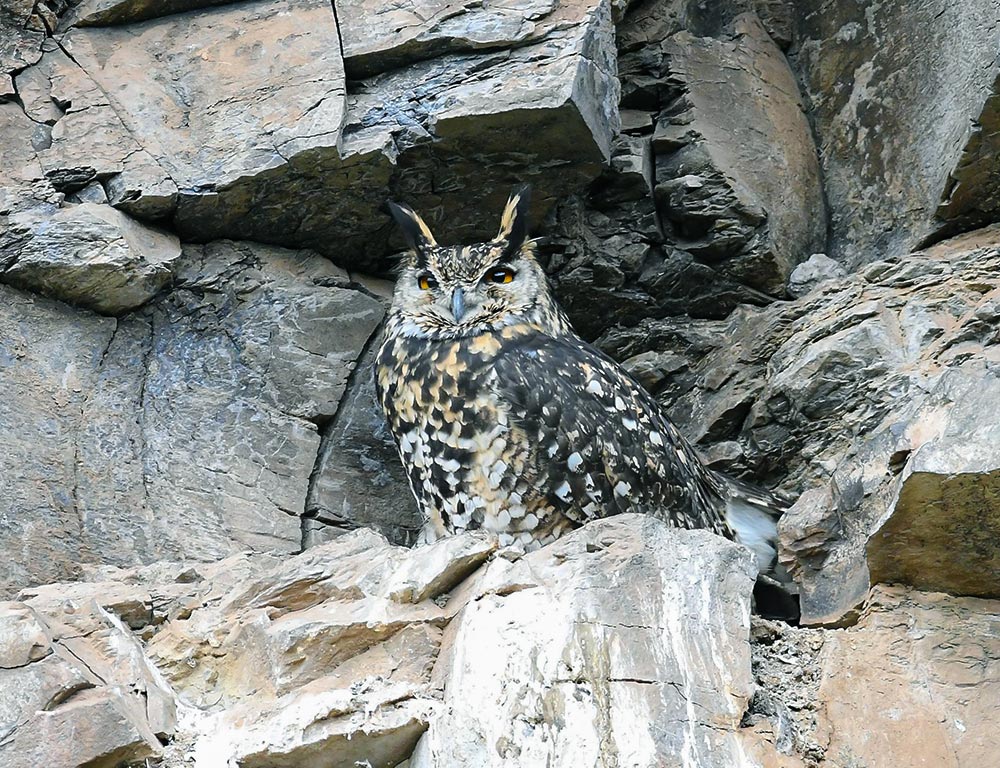
- Scientific name: Bubo capensis
- Size: 45-60 cm
- Weight: 1200-2100 g
- Population: Stable
- Life span: Up to 20 years
- Food: Small mammals, birds, and insects
- Wingspan: Around 110-150 cm
- Status: Least Concern
The Cape Eagle Owl, Bubo capensis, is a robust owl species with distinctive ear tufts and striking orange eyes.
Inhabiting a range of environments, from semi-desert regions to forests, these owls are opportunistic hunters, feeding on small mammals, birds, and insects. With a stable population and no imminent threats, the Cape Eagle Owl is classified as Least Concern.
Their adaptability to various habitats and effective nocturnal hunting strategies make them an integral part of Africa’s avian diversity, contributing to the ecological balance of their respective ecosystems.
9. Marsh Owl
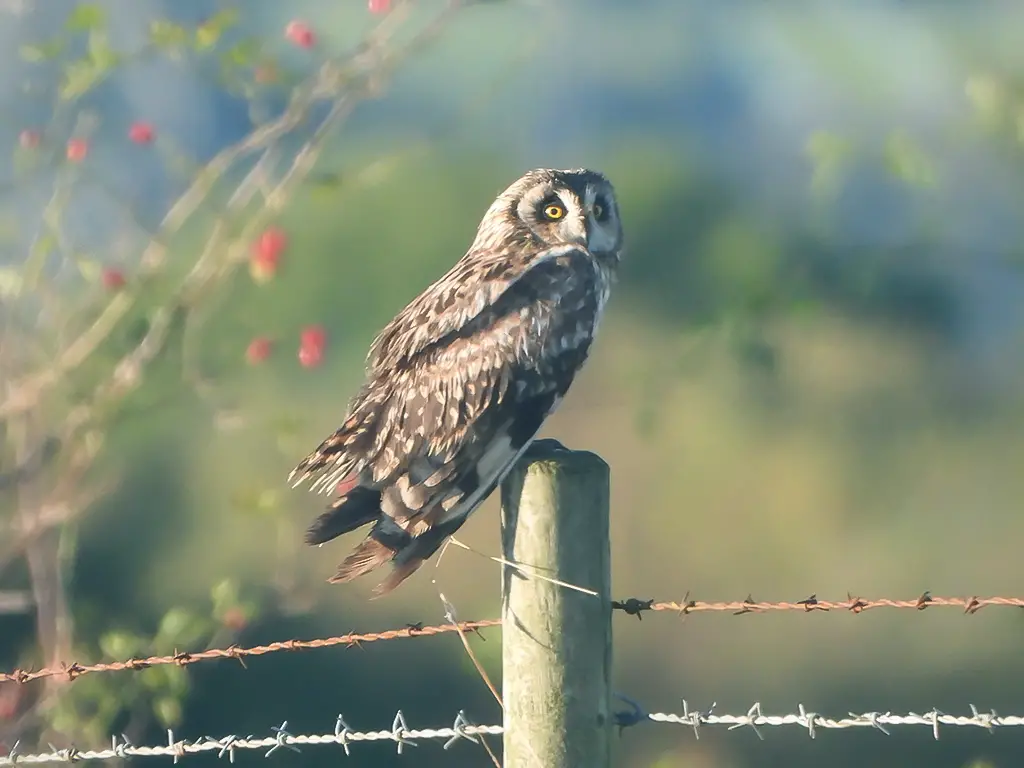
- Scientific name: Asio capensis
- Size: 35-40 cm
- Weight: 300-400 g
- Population: Declining; Near Threatened
- Life span: Information not well-documented
- Food: Small mammals, birds, and insects
- Wingspan: Approximately 95 cm
- Status: Near Threatened
The Marsh Owl, Asio capensis, is a medium-sized owl species with a distinctive facial disc and a preference for wetland habitats such as marshes and grasslands.
Recognizable by its buff-colored plumage and orange eyes, these owls primarily feed on small mammals, birds, and insects.
Unfortunately, their population is experiencing a decline, earning them a Near Threatened status. Threats include habitat degradation, loss, and changes in land use.
Conservation efforts focused on preserving wetland ecosystems are essential for the survival of the Marsh Owl, contributing to the broader biodiversity of African landscapes.
10. Pel’s Fishing Owl
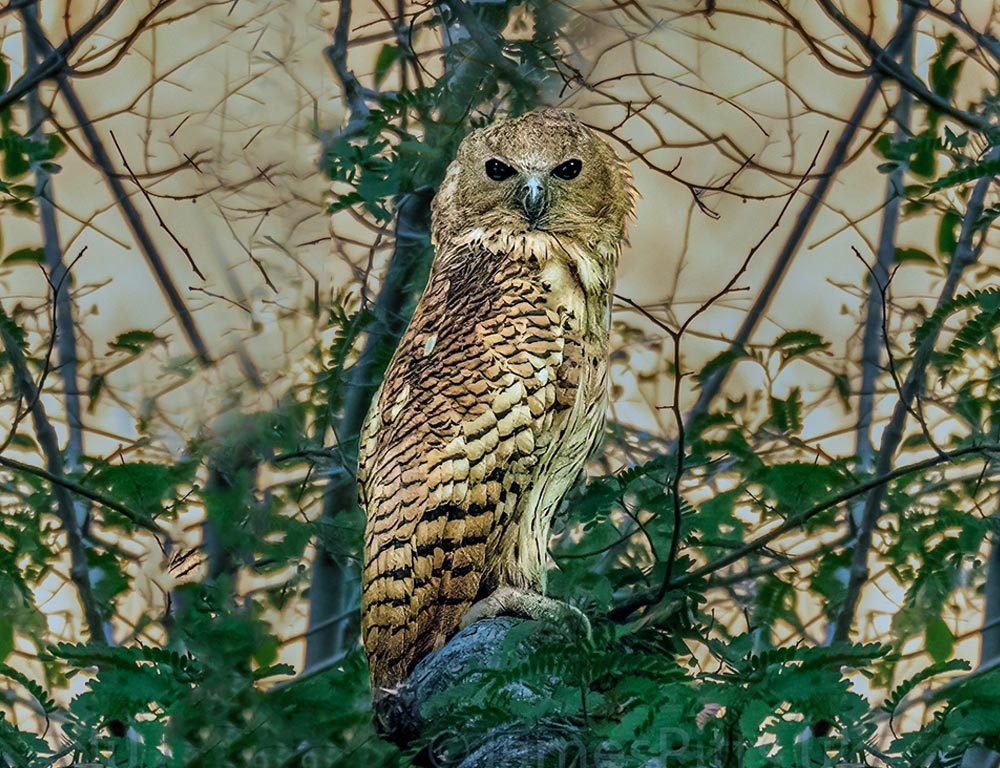
- Scientific name: Scotopelia peli
- Size: 50-63 cm
- Weight: 1.6-2.1 kg
- Population: Declining; Vulnerable
- Life span: Information not well-documented
- Food: Fish, crustaceans, and occasionally small mammals and birds
- Wingspan: Approximately 150 cm
- Status: Vulnerable
Pel’s Fishing Owl, Scotopelia peli, is a large and distinctive owl species, known for its preference for riparian habitats and its unique diet primarily consisting of fish.
Recognizable by its brown plumage, large size, and distinctive facial features, these owls face a declining population, earning them a Vulnerable status. Threats include habitat loss, disturbance, and potential declines in fish populations.
Preserving riverine habitats and implementing conservation strategies are crucial for the survival of Pel’s Fishing Owl, contributing to the ecological health of river ecosystems in Africa.
11. Pearl-spotted Owlet
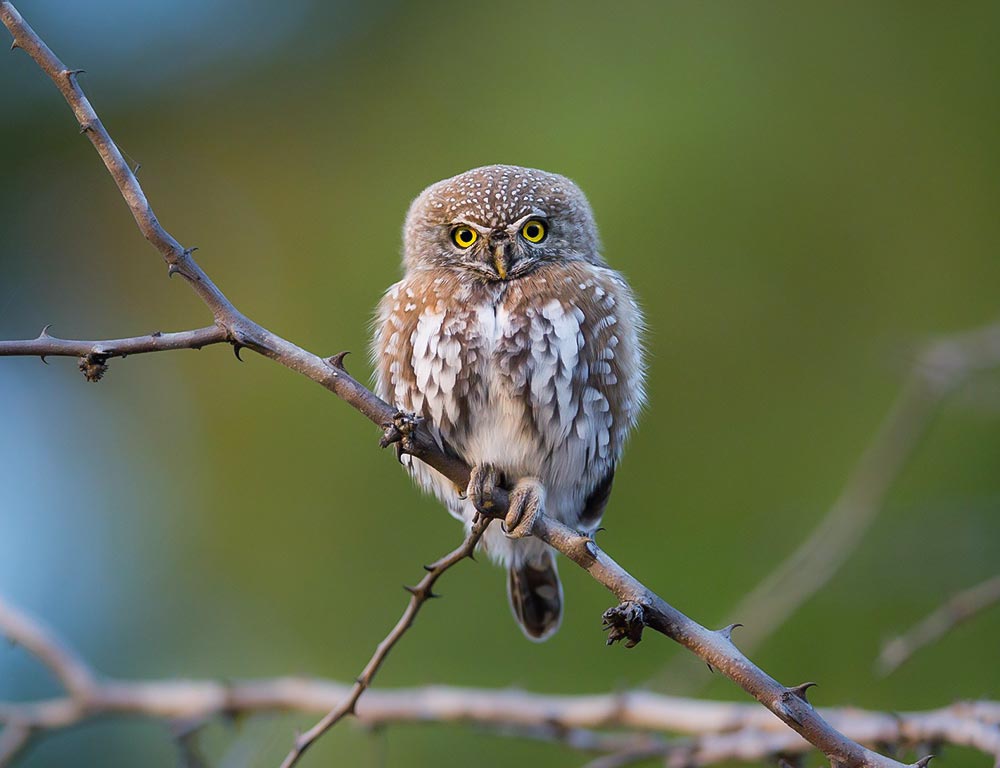
- Scientific name: Glaucidium perlatum
- Size: 17-21 cm
- Weight: 60-80 g
- Population: Common and widespread
- Life span: Up to 10 years
- Food: Insects and small vertebrates
- Wingspan: Approximately 45 cm
- Status: Least Concern
The Pearl-spotted Owlet, Glaucidium perlatum, is a small and agile owl species recognized for its distinctive pearl-like spots on its plumage.
Inhabiting a range of habitats from woodlands to savannas, these owlets are skilled hunters, preying on insects and small vertebrates. Common and widespread, they face no significant conservation concerns and are classified as Least Concern.
Their adaptability to various environments and efficient insect control make them a familiar and welcomed presence in Africa’s diverse ecosystems.
12. African Barred Owlet
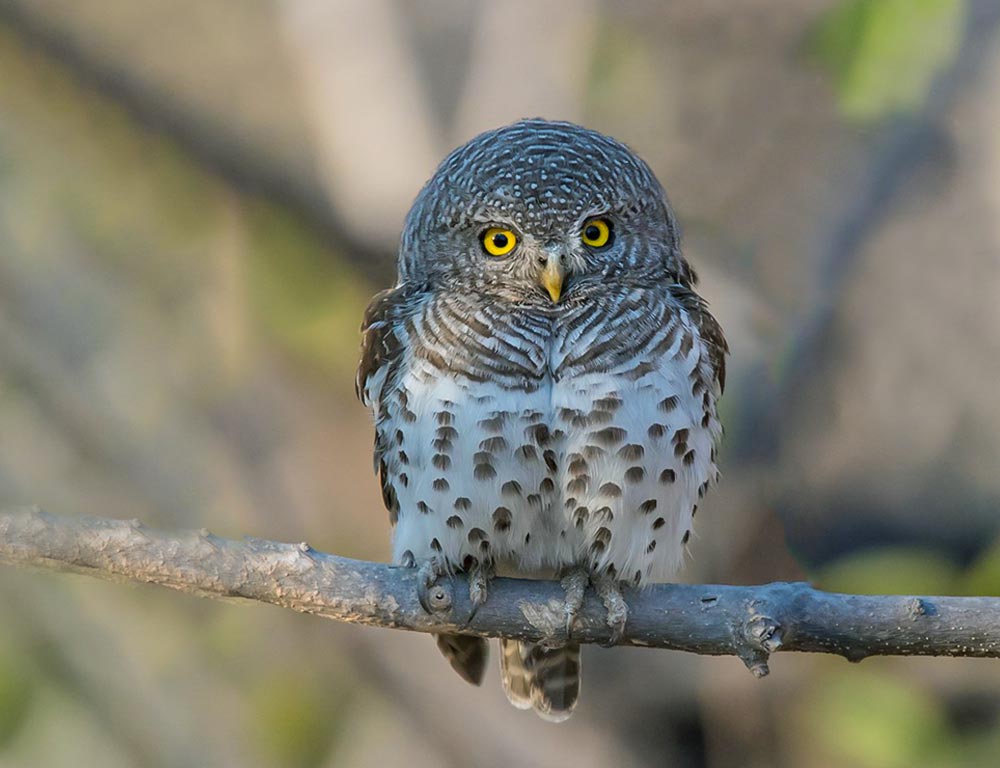
- Scientific name: Glaucidium capense
- Size: 20-23 cm
- Weight: 75-95 g
- Population: Stable; widespread
- Life span: Up to 10 years
- Food: Insects and small vertebrates
- Wingspan: Approximately 45 cm
- Status: Least Concern
The African Barred Owlet, Glaucidium capense, is a small owl species with barred plumage and distinctive facial markings.
Inhabiting various landscapes, including forests and woodlands, these owlets are efficient hunters, primarily feeding on insects and small vertebrates.
With a stable population and widespread distribution, the African Barred Owlet faces no significant threats and is classified as Least Concern.
Their adaptability to different environments and crucial role in pest control contribute to their significance in maintaining the ecological balance of African ecosystems.
13. Greyish Eagle Owl
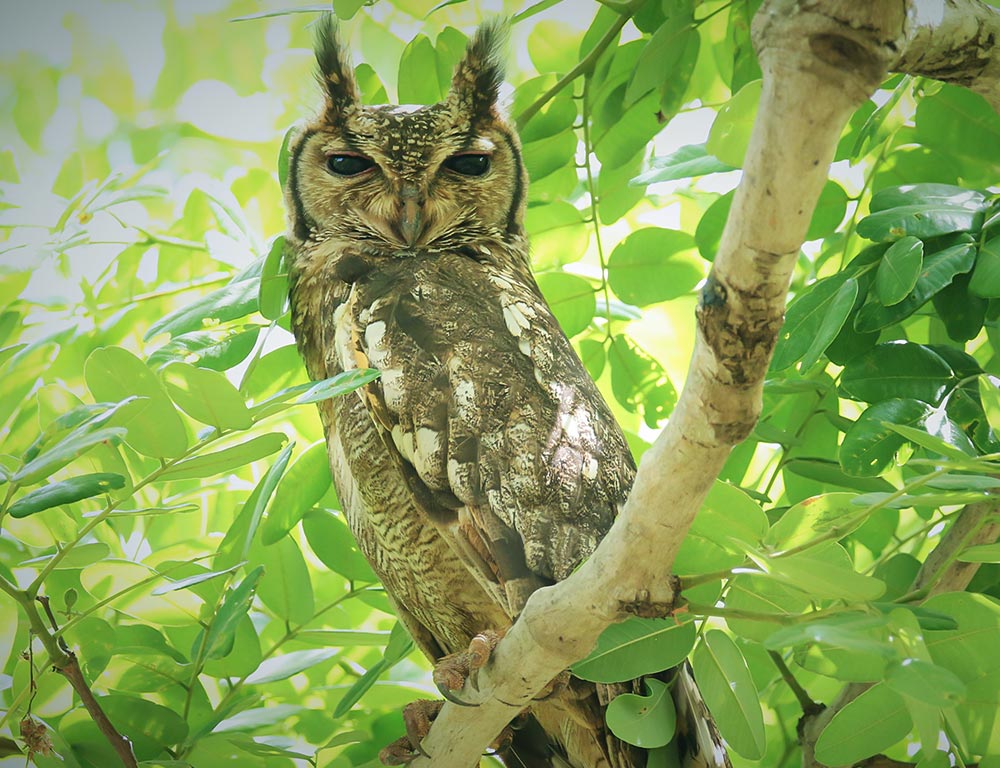
- Scientific name: Bubo cinerascens
- Size: 50-60 cm
- Weight: 950-1400 g
- Population: Insufficient data; potentially declining
- Life span: Information not well-documented
- Food: Small mammals, birds, and insects
- Wingspan: Approximately 125-140 cm
- Status: Data Deficient
The Greyish Eagle Owl, Bubo cinerascens, is a large owl species with a cryptic grayish-brown plumage. Inhabiting savannas and open woodlands, these owls are skilled predators, preying on small mammals, birds, and insects.
Unfortunately, there is insufficient data on their population trends, and their conservation status is labeled as Data Deficient.
Research efforts are essential to understanding the ecological roles of the Greyish Eagle Owl and implementing conservation measures to ensure their continued presence in African ecosystems.
14. Fraser’s Eagle Owl
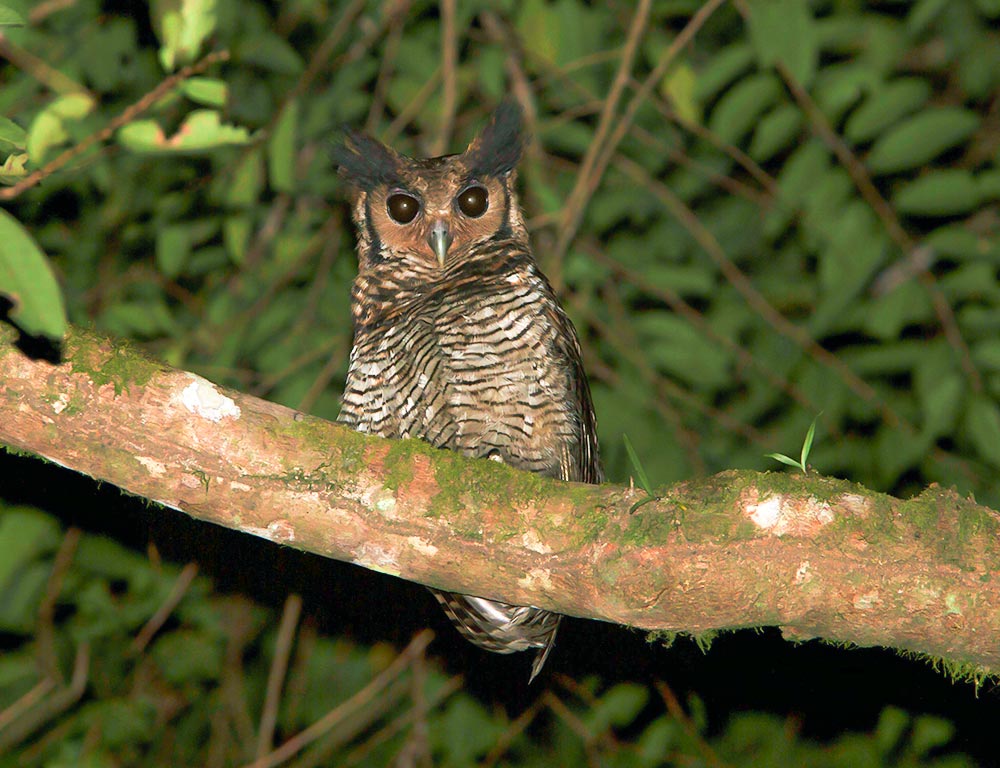
- Scientific name: Bubo poensis
- Size: 50-60 cm
- Weight: 1.5-2.5 kg
- Population: Data deficient; potentially declining
- Life span: Information not well-documented
- Food: Small mammals, birds, and insects
- Wingspan: Approximately 140 cm
- Status: Data Deficient
Fraser’s Eagle Owl, Bubo poensis, is a large and powerful owl species found in Central and West Africa. Recognizable by its prominent ear tufts and distinct facial features, these owls are skilled hunters, preying on small mammals, birds, and insects.
Unfortunately, the lack of comprehensive data on their population trends categorizes Fraser’s Eagle Owl as Data Deficient.
Research efforts are crucial for understanding their ecological roles and implementing conservation measures to safeguard their presence in the diverse ecosystems of Central and West Africa.
Wrapping Up
The diverse array of owls inhabiting the vast landscapes of Africa showcases the continent’s rich avian tapestry and ecological resilience.
From the iconic Verreaux’s Eagle Owl with its majestic presence to the elusive African Grass Owl navigating through dense grasslands, each species contributes uniquely to the intricate balance of ecosystems.
These enigmatic birds, with their nocturnal prowess and efficient hunting strategies, play pivotal roles in controlling insect and rodent populations and maintaining ecological equilibrium.
While some face conservation challenges, such as the declining Marsh Owl and the elusive Fraser’s Eagle Owl, the majority, like the adaptable African Wood Owl and resilient African Scops Owl, continue to thrive across diverse habitats.
Conservation efforts are imperative to safeguard these fascinating creatures from threats like habitat loss and changing land use.
Exploring the world of Africa’s 14 owl species reveals not just the captivating beauty of these birds, but also their crucial ecological contributions.